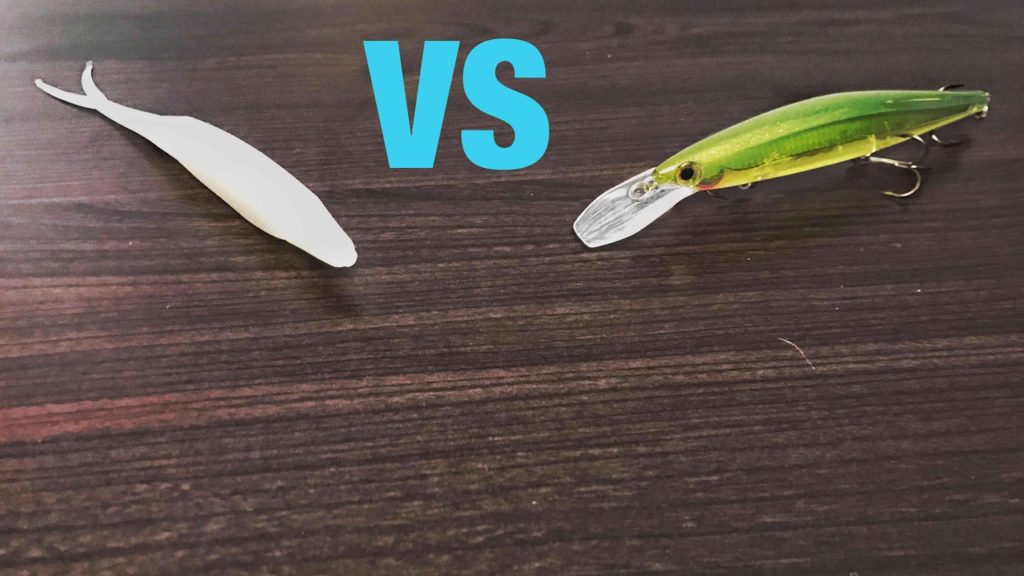Soft Baits vs. Hard Baits

As the saying goes, you have to have the right tools for the job. When I, Matthew Davies, first started fishing, I would bring along littler more than my pole and a container of worms. Over time, I began to realize that worms were not the best bait to use in every situation. As I ventured from fishing on land to fishing on a boat, I found that bigger fish were not biting on the worms. I talked to many of my fishing buddies that I had met over the years, and they suggested every different type of bait you can imagine. However, after evaluating what they were proposing, I discovered that the baits they were suggesting fell into two categories – soft bait and hard bait. To help you better understand these baits, and when to use them, I have decided to do a blog post dedicated to them. Below you will find these two categories with a definition, an explanation of the history and uses for each.
Soft Bait
Soft baits are defined as any bait that is not made of a rigid material. This includes all of you live baits as well as plastic baits. The reason that they are used is that they are relatively cheap as far as bait is concerned. You can usually pick up a dozen live worms for about $5 at any corner store near the water.
Soft bait is the primary bait people have used for years. In the late 1950s, small worms and grubs were developed and made from hard rubber. They were still considered soft bait as you could quite easily stick a hook into them. The drawback to this hard rubber, though, was that they did not give a natural look like their live counterparts. Meaning, often, fish would not bite at them as they did not look real enough. It wasn’t until 1967 that soft bait as we know today was introduced and developed by Tom Mann. The bait even came in an assortment of flavors such as strawberry and grape. These were artificial flavors and scents. It was assumed that the scent would attract the fish but these scents did not entice the fish as expected. In 1972, more lifelike baits were starting to be introduced. These included curly tails and appendages – to make the bait look more similar to natural prey.
When it comes to using these soft baits, you will need a vast knowledge of different riggings and knots. Depending on the type of fish you are looking for, various presentations of the bait will be required. When you are looking to fish for topwater feeders, for example, you will want a more buoyant rig. This will allow the plastic bait to float near the top of the water. By contrast, if you are looking to catch bottom-feeding fish, you will have to make the switch to weighted jigheads. The addition of line weights or bobbers will additionally help you to achieve the desired depth on your bait.
The primary uses for soft bait are to have more maneuverability and less snag on the bottom of the lake, river, or ocean floor.
Hard Bait
In contrast to soft baits, hard baits are hard and rigid. This includes both wooden and plastic varieties. You will find that many of these hard baits can be quite expensive, depending on size, shape, and intended use.
As far as baits are concerned, hard bait is relatively new. The first hard baits were designed in the early part of the 1950s. They were generally made of wood or metal. The most common among these is spinnerbait. Essentially, the metal “spoon” will spin around and reflect light. This mimics the light reflecting off the scales of a fish. In muddy water, the fish cannot tell the difference between the sun reflecting off a spinner and sun reflecting off a fish.
Using hard bait is much more complicated than using soft bait because they require using special techniques, as opposed to casting and waiting. Therefor, using hard baits requires that you know and understand the fish in your area and what entices them.
Hard baits are also commonly referred to as lures. The reason for this is that they lure the fish to bite on it. For that reason, you need to be aware of different techniques and varieties.
One technique is called the popper. It involves casting your line out into the water, then when retrieving the lure, giving a slight jerk to the fishing rod, simulating a struggling fish. This is a desirable trait for a predatory fish. Popper bait is best used in coves with shallow water and not much wind. They are very light, so you will have a hard time casting them any measurable distance.
One hard bait that is popular among experienced fishermen is crankbait. In the world of lures, they are as complicated as they come. This hard-plastic lure comes with a variety of spoons on the front of the fish. Each design dictates the depth in which the fish will dive when you are reeling the line in. The shorter the spoon, the shallower it goes. Conversely, the larger the spoon, the deeper it will dive.
Today, a third type of bait has come on the market: hybrid baits. These baits have both soft and hard properties. This is especially useful when fishing for species that like to hunt species with a hard exterior but a soft interior. I predict we will be seeing even more hybrids in the years to come.
Conclusion
I, Matthew Davies, hope that you have found this blog useful. I will be doing more blogs in the future that will showcase each bait in much more detail. This blog aimed to provide you with a brief overview of the different types of bait that you can use when you hit the fishing hole this weekend.